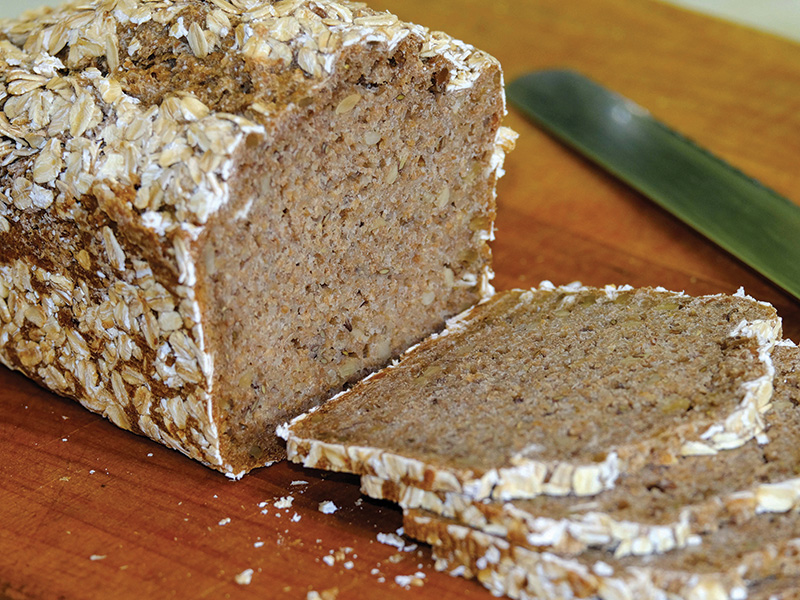By Pat Teti —
Who would have thought that toilet paper and baking yeast would be two of the most talked about items in short supply during a pandemic? The surge in home baking has been a positive outcome during an otherwise grim situation, but the difficulty of finding yeast seems to have thwarted some baking plans.

This got me thinking about ways of using less commercial yeast and inspired me to review my favourite recipes and experiment with new ones. In this article, I describe four strategies for being less dependent on commercial baking yeast while also expanding your creative options. They include yeasted bread using a fraction of the normal amount of yeast, using sourdough starter, quick bread, and unleavened bread.
Option 1 – Start bread with a pinch of yeast
You might be surprised that you can make an oven full of yeasted bread starting with only a pinch of instant yeast. I use this technique to make my favourite every-day bread, which I call “fermented ultragrain” (https://iberianpixels.blogspot.com/2019/07/whole-grain-bread-can-be-ultra-delicious.html) but it can be used for almost any yeasted bread. The key is to make a “pre-ferment” consisting of all the water in the recipe, half of the flour, and a pinch of instant yeast. Let it sit covered at room temperature for a few days and then follow the rest of the recipe. I use only 1/8th of a teaspoon of yeast to make four large loaves. Another recipe is in one of my previous Green Gazette articles, https://thegreengazette.ca/recipes-squashed-bread/
The pre-ferment, known as a “poolish” or “bigaliquida,” develops a wonderful fermented aroma. In fact, it becomes a sourdough and a portion can be saved as a starter. Multi-day fermentation improves the digestibility, flavour, and keeping qualities of bread. If you use this method, you don’t need to maintain a starter, and it’s more predictable than sourdough. A 100 gram jar of instant yeast is sufficient to make hundreds of batches of bread and keeps for years if stored in the refrigerator.
Option 2 – Sourdough from a starter
Sourdough baking produces yeasted bread without packaged yeast, and if you’re a sourdough baker, you might recognize option 1 as being similar to how you make bread already. In fact, I don’t need to tell you how to make bread. However, if you’re new to sourdough baking or if you are wondering about the viability of your starter, then I suggest that you try making sourdough using option 1 and save a jar of the three-day old poolish as your new starter. Just take it before adding the rest of the dry ingredients. A half pint is plenty. Even if you start with a pinch of commercial yeast, it will “go wild” over time due to the diversity of yeast and bacteria that are present in grains and in the air. Many websites describe how to work with sourdough, but I just keep my starter in a jar and freeze it if I’m not going to use it within a week.
Option 3 – Unyeasted quick bread
Quick breads don’t require any yeast because they use baking soda or baking powder, which release CO2 gas during baking. They’re also fast because they don’t have to be given time to ferment or rise—just mix and bake. I prefer baking soda over baking powder because it has fewer chemicals. There are hundreds of quick bread recipes online, but my current favourite is a whole grain quick bread with dates, nuts, and no refined sugar. You can read about it in my blog here: https://iberianpixels.blogspot.com/2020/03/a-quick-and-healthy-bread.html
Option 4 – Unleavened baking
It’s easy to overlook unleavened baking but there are many delicious recipes, especially for flatbreads and thin cakes. I’ll never forget the first time I had “torta di cecci” in Italy. It’s a thin cake made from garbanzo bean flour, olive oil, and rosemary. I would never have thought that something that good could be made with bean flour. It’s easy to make, and the Williams Lake Bulk Barn carries bean, chick pea, and lentil flours. Watch for a future article on torta di cecci.
Pat Teti was a research scientist with the BC government for 18 years and has always enjoyed making things.

